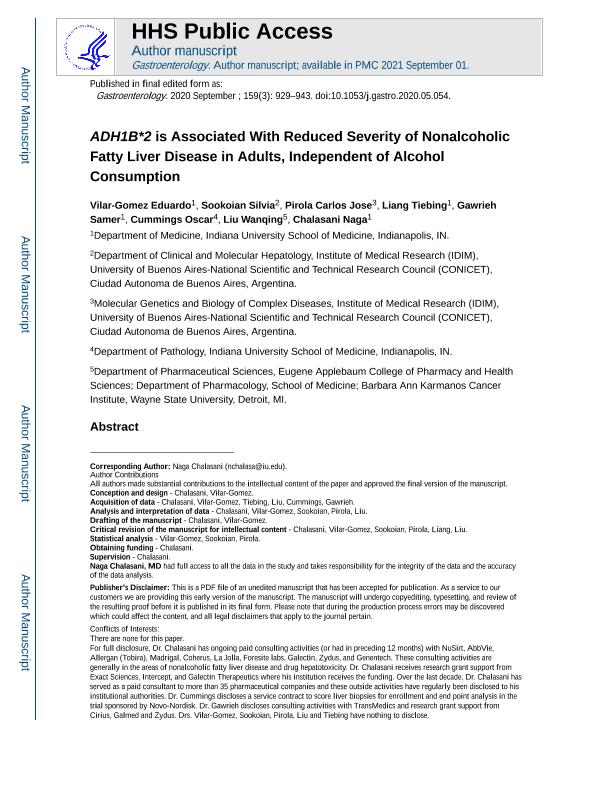Mostrar el registro sencillo del ítem
dc.contributor.author
Vilar Gomez, Eduardo
dc.contributor.author
Sookoian, Silvia Cristina

dc.contributor.author
Pirola, Carlos José

dc.contributor.author
Liang, Tiebing
dc.contributor.author
Gawrieh, Samer
dc.contributor.author
Cummings, Oscar
dc.contributor.author
Liu, Wanqing
dc.contributor.author
Chalasani, Naga P.
dc.date.available
2020-10-29T14:51:32Z
dc.date.issued
2020-05
dc.identifier.citation
Vilar Gomez, Eduardo; Sookoian, Silvia Cristina; Pirola, Carlos José; Liang, Tiebing; Gawrieh, Samer; et al.; ADH1B∗2 Is Associated With Reduced Severity of Nonalcoholic Fatty Liver Disease in Adults, Independent of Alcohol Consumption; W B Saunders Co-Elsevier Inc; Gastroenterology; 159; 3; 5-2020; 929-943
dc.identifier.issn
0016-5085
dc.identifier.uri
http://hdl.handle.net/11336/117147
dc.description.abstract
Background & Aims: Alcohol dehydrogenase 1B (ADH1B) is involved in alcohol metabolism. The allele A (ADH1B∗2) of the rs1229984: A>G variant in ADH1B is associated with a higher alcohol metabolizing activity compared to the ancestral allele G (ADH1B∗1). Moderate alcohol consumption is associated with reduced severity of nonalcoholic fatty liver disease (NAFLD), based on histologic analysis, compared with no alcohol consumption. However, it is unclear whether ADH1B∗2 modifies the relationship between moderate alcohol consumption and severity of NAFLD. We examined the association between ADH1B∗2 and moderate alcohol consumption and histologic severity of NAFLD. Methods: We collected data from 1557 multiethnic adult patients with biopsy-proven NAFLD enrolled into 4 different studies conducted by the Nonalcoholic Steatohepatitis (NASH) Clinical Research Network. Histories of alcohol consumption were obtained from answers to standardized questionnaires. Liver biopsy samples were analyzed by histology and scored centrally according to the NASH Clinical Research Network criteria. We performed covariate adjusted logistic regressions to identify associations between histologic features of NAFLD severity and moderate alcohol consumption and/or ADH1B∗2. Results: A higher proportion of Asians/Pacific Islanders/Hawaiians carried the ADH1B∗2 allele (86%) than other racial groups (4%–13%). However, the study population comprised mostly non-Hispanic whites (1153 patients, 74%), so the primary analysis focused on this group. Among them, 433 were moderate drinkers and 90 were ADH1B∗2 carriers. After we adjusted for confounders, including alcohol consumption status, ADH1B∗2 was associated with lower frequency of steatohepatitis (odds ratio [OR], 0.52; P <.01) or fibrosis (odds ratio, 0.69; P =.050) compared with ADH1B∗1. Moderate alcohol consumption (g/d) reduced the severity of NAFLD in patients with ADH1B∗1 or ADH1B∗2. However, ADH1B∗2, compared to ADH1B∗1, was associated with a reduced risk of definite NASH (ADH1B∗2: OR, 0.80; P <.01 vs ADH1B∗1: OR, 0.96; P =.036) and a reduced risk of an NAFLD activity score of 4 or higher (ADH1B∗2: OR, 0.83; P =.012 vs ADH1B∗1: OR, 0.96; P =.048) (P <.01 for the difference in the effect of moderate alcohol consumption between alleles). The relationship between body mass index and NAFLD severity was significantly modified by ADH1B∗2, even after we controlled for alcohol consumption. Conclusions: ADH1B∗2 reduces the risk of NASH and fibrosis in adults with NAFLD regardless of alcohol consumption status. ADH1B∗2 might modify the association between high body mass index and NAFLD severity.
dc.format
application/pdf
dc.language.iso
eng
dc.publisher
W B Saunders Co-Elsevier Inc

dc.rights
info:eu-repo/semantics/openAccess
dc.rights.uri
https://creativecommons.org/licenses/by-nc-sa/2.5/ar/
dc.subject
HISTOLOGY
dc.subject
OUTCOME
dc.subject
PROGRESSION
dc.subject
RISK FACTOR
dc.subject.classification
Gastroenterología y Hepatología

dc.subject.classification
Medicina Clínica

dc.subject.classification
CIENCIAS MÉDICAS Y DE LA SALUD

dc.title
ADH1B∗2 Is Associated With Reduced Severity of Nonalcoholic Fatty Liver Disease in Adults, Independent of Alcohol Consumption
dc.type
info:eu-repo/semantics/article
dc.type
info:ar-repo/semantics/artículo
dc.type
info:eu-repo/semantics/publishedVersion
dc.date.updated
2020-10-14T21:21:56Z
dc.journal.volume
159
dc.journal.number
3
dc.journal.pagination
929-943
dc.journal.pais
Estados Unidos

dc.journal.ciudad
Philadelphia
dc.description.fil
Fil: Vilar Gomez, Eduardo. Indiana University. School Of Medicine.; Estados Unidos
dc.description.fil
Fil: Sookoian, Silvia Cristina. Consejo Nacional de Investigaciones Científicas y Técnicas. Oficina de Coordinación Administrativa Houssay. Instituto de Investigaciones Médicas. Universidad de Buenos Aires. Facultad de Medicina. Instituto de Investigaciones Médicas; Argentina
dc.description.fil
Fil: Pirola, Carlos José. Consejo Nacional de Investigaciones Científicas y Técnicas. Oficina de Coordinación Administrativa Houssay. Instituto de Investigaciones Médicas. Universidad de Buenos Aires. Facultad de Medicina. Instituto de Investigaciones Médicas; Argentina
dc.description.fil
Fil: Liang, Tiebing. Indiana University. School Of Medicine.; Estados Unidos
dc.description.fil
Fil: Gawrieh, Samer. Indiana University. School Of Medicine.; Estados Unidos
dc.description.fil
Fil: Cummings, Oscar. Indiana University. School Of Medicine.; Estados Unidos
dc.description.fil
Fil: Liu, Wanqing. Indiana University. School Of Medicine.; Estados Unidos
dc.description.fil
Fil: Chalasani, Naga P.. Indiana University. School Of Medicine.; Estados Unidos
dc.journal.title
Gastroenterology

dc.relation.alternativeid
info:eu-repo/semantics/altIdentifier/url/https://www.gastrojournal.org/article/S0016-5085(20)34707-7/fulltext
dc.relation.alternativeid
info:eu-repo/semantics/altIdentifier/doi/http://dx.doi.org/10.1053/j.gastro.2020.05.054
Archivos asociados
